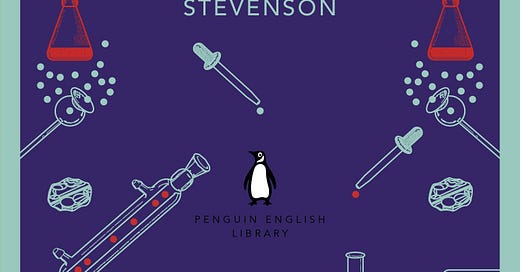Dr Jekyll and Mr Hyde by Robert Louis Stevenson
"This, too, was myself. It seemed natural and human."
Strange Case of Dr Jekyll and Mr Hyde by Robert Louis Stevenson (Longmans, Green & Co., 1886)
There is an evil that lurks inside us all, and it is called: thinking you know what something is about without actually having bothered to read it.
That said, when it comes to this particular book, I can’t be alone in that. The doctor and his other half have long since left the literature for the language, and have together become a universal reference well past the point of cliché. Inconsistent football teams have Jekyll & Hyde seasons. Stock markets have Jekyll & Hyde periods. Everybody knows the story; everybody knows what the story means. Good and Bad, Bad and Good, back and forth between them until everybody’s unhappy.
Tell you what, though. Perhaps I’m an idiot, but I didn't realise Hyde was small.
But small he is! Presumably this is how real fans of the book - the Hydeheads, the Jekyll Hive - sniff out the frauds and spoofers. Big, is he? Monstrous, aye? We've got another one, lads. He thinks everything works like Hulk.
Hyde first appears as "a little man who was stumping along eastward at a good walk." Not just small, then, but "stumping"; small and a little odd. He is later described as "dwarfish", and then towards the end, by Dr J's own description, we learn that Hyde is "less robust and less developed … smaller, slighter and younger." Jekyll’s own hand
was professional in shape and size: it was large, firm, white and comely. But the hand which I now saw, lying half shut on the bed clothes, was lean, corded, knuckly, of a dusky pallor and thickly shaded with a smart growth of hair. It was the hand of Edward Hyde.
Hairy, dusky, with a stumping gait: this landed on my 21st-century sensitivities with certain 'hierarchy of the races' implications, though perhaps in the late 19th it was meant to have more (de-)evolutionary overtones, Darwin having blown the world up mere decades before. And maybe that’s not a distinction worth drawing - racist evolutionary hierarchies were pretty respectable well into the 20th century, and can still be found in some dank corners today. Either way, I think the most interesting word in the quote above is "professional".
In his general aspect, Dr Jekyll is "a large, well-made, smooth-faced man of fifty." His friend Dr Lanyon, meanwhile, is "a hearty, healthy, dapper, red-faced gentleman." But Jekyll is physically emptied out and literally diminished by his transformation into Hyde, while Lanyon, upon discovering just what his old friend has been up to, suffers a shock so severe that he loses weight, hair and years of his life.
The richness and the goodness of the good rich doctors can be read in their bodies, in the redness of their faces and the professionalism of their large, firm, white hands. A life well lived results in a body well fleshed out; an ill character is written not just on the face, phrenology-style - "there is something wrong with [Hyde's] appearance; something displeasing, something downright detestable" - but in the hunch of the shoulders and in those hands. Lean. Corded. Not professional, no, but certainly hard worked. A spectre is haunting London…
Of course, it's not just the size that the cliché gets wrong - it's also the implied divide of the divide between Good and Bad. Hyde is definitely Bad, but Jekyll certainly isn't uncomplicatedly Good. As the man himself puts it, one of his two identities was "wholly evil, while the other was still the same old Henry Jekyll, that incongruous compound of whose reformation and improvement I had already learned to despair."
The second part of that will be familiar territory for anybody whose football team has had a Jekyll & Hyde season: we could probably just call them Jekyll seasons, and save ourselves all a couple of valuable syllables. Turns out, when you actually get around to reading the book, the Hyde was a given all along.



